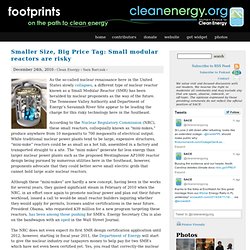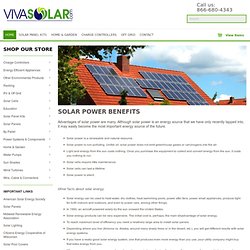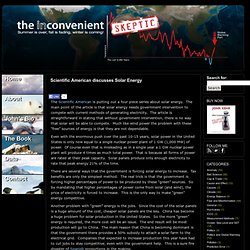

7 Reasons why nuclear power is bad for the environment and the nation - National Environmental News. The industry of big energy has been at it again, pushing government officials to allow for more options that will put money in their pockets even though it will have a negative back lash for the country.

With their new lobbying and ad campaigns pushing for this new energy that they claim will save us from of our economic and environmental ills, are they really dealing honestly with us? The truth is nuclear power is dangerous, costly, and will create more problems that it could ever hope to solve. NuScale Power. Small Modular Reactors: Fact Sheet - Institute for Energy and Environmental Research. Footprints » Archive » Smaller Size, Big Price Tag: Small modular reactors are risky.
As the so-called nuclear renaissance here in the United States slowly collapses, a different type of nuclear reactor known as a Small Modular Reactor (SMR) has been heralded by nuclear proponents as the way of the future.

The Tennessee Valley Authority and Department of Energy’s Savannah River Site appear to be leading the charge for this risky technology here in the Southeast. According to the Nuclear Regulatory Commission (NRC), these small reactors, colloquially known as “mini-nukes,” produce anywhere from 10 megawatts to 700 megawatts of electrical output. While traditional nuclear power plants tend to be large, expensive structures, “mini-nuke” reactors could be as small as a hot tub, assembled in a factory and transported straight to a site.
Once again mini-nuke proponents claim that SMR technology won’t have the many problems that have plagued large-scale nuclear reactors such as cost, safety, and radioactive waste. This is far from the truth. Reacteurs nucleaires dans le monde2011.png. Feature: Small modular nuclear reactors - the future of energy? - Images. This year is an historic one for nuclear power, with the first reactors winning U.S. government approval for construction since 1978.

Some have seen the green lighting of two Westinghouse AP1000 reactors to be built in Georgia as the start of a revival of nuclear power in the West, but this may be a false dawn because of the problems besetting conventional reactors. It may be that when a new boom in nuclear power comes, it won't be led by giant gigawatt installations, but by batteries of small modular reactors (SMRs) with very different principles from those of previous generations. But though a technology of great diversity and potential, many obstacles stand in its path. Gizmag takes an in-depth look at the many forms of SMRs, their advantages, and the challenges they must overcome. View all Globally, there is a growing demand for electricity that is cheap, reliable and abundant. Not only complicated, but expensive and potentially dangerous. Then there are safety issues. Solar Panels - Solar Thermal Vs. Photovoltaic - Technorati Green.
As we search for ways to become a more green society, the first thing that often comes to mind is solar energy. Harnessing the sun’s power to provide energy seems fairly innocuous to the environment, right? That is not always true. Actually, large amounts of fossil fuels are used in the manufacture of some of the panels, and the disposal of the waste metals not used present their own set of problems. Mercury and chromium are two of the most toxic. What options do we have?
Solar thermal uses flat collector plates to harness the sun’s energy to heat water. Many solar developers who had been permitted for solar thermal are now considering, or have already made the decision to move to photovoltaic technology due to the sharp reduction in the cost of PV panels. Portail de ressources du CDI du lycée Alain - Alençon. Environmental Impacts of Renewable Energy Technologies.
Wind Power | Solar Power | Geothermal Energy | Biomass for ElectricityHydroelectric Power | Hydrokinetic Energy All energy sources have some impact on our environment.

Fossil fuels — coal, oil, and natural gas — do substantially more harm than renewable energy sources by most measures, including air and water pollution, damage to public health, wildlife and habitat loss, water use, land use, and global warming emissions. Learn more: The Benefits of Renewable Energy Use It is still important, however, to understand the environmental impacts associated with producing power from renewable sources such as wind, solar, geothermal, biomass, and hydropower. The exact type and intensity of environmental impacts varies depending on the specific technology used, the geographic location, and a number of other factors.
SOLAR POWER BENEFITS. Advantages of solar power are many.

13 Fundamental Advantages and Disadvantages of Solar Energy. By Greg Whitburn Solar energy is becoming increasingly popular as the world takes notice of the burgeoning carbon emission problems that come with burning fossil fuels.

But why all the fuss? 2015 has been a particularly significant year for solar, seeing a dramatic drop in the price of solar panels, along with the refining of advantageous public funding models. The Hazards of Solar Energy. Over the years I have heard and read much nonsense, to the point where nothing surprises me any more.

Recently an item caught my eye, a pamphlet put out by the Citizens' Reactionary Alliance Concerned with Keeping the Environment Decent. It's a nice example of the style and `logic' common to propaganda pieces from many groups of alarmists and `aginers.' — Donald E. Simanek Many groups and individuals are proposing that our government spend tax money on research and development of systems to utilize solar energy.
They urge construction of vast solar energy collectors to convert sunlight to electricity to supply our energy needs. We view these proposals with alarm. The Limitations of Solar Energy and the Future of Solar Technology. LE FONCTIONNEMENT DES PANNEAUX SOLAIRES PHOTOVOLTAIQUES ET TERMIQUES - TPE. Nous pouvons distinguer deux types de panneaux solaires : - Les panneaux solaires thermiques : Ces panneaux convertissent la lumière en chaleur.

Ils sont souvent utilisés dans des installations domestiques où ils sont reliés à un chauffe-eau. - Les panneaux solaires photovoltaïques : Plus complexes, ils transforment la lumière du Soleil directement en électricité. Sommaire Les panneaux solaires thermiques Les panneaux solaires thermiques transforment la lumière en chaleur, le plus souvent pour des chauffe-eaux. Ce schéma montre bien le circuit de l'eau qui va circuler dans le panneau et s'échauffer.
Ensuite, le liquide caloporteur chaud qui sort des tuyaux va dans le chauffe-eau et transmet son énergie thermique (chaleur) à l'eau sanitaire présente dans le chauffe-eau. Voir aussi : Coûts et Rentabilité pour voir les économies que peut apporter un tel panneau. The Inconvenient Skeptic » Scientific American discusses Solar Energy. The Scientific American is putting out a four piece series about solar energy.
